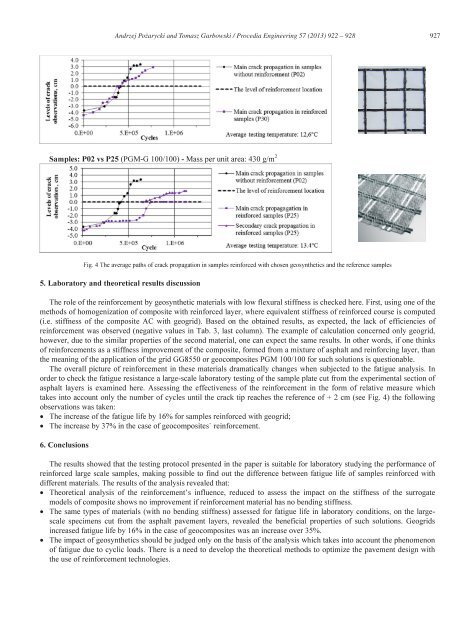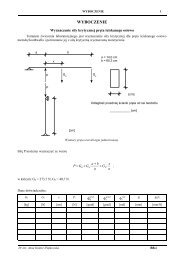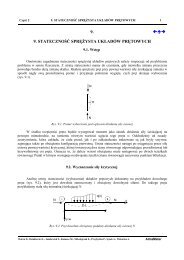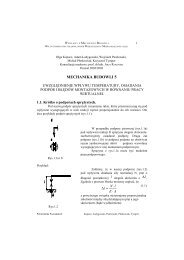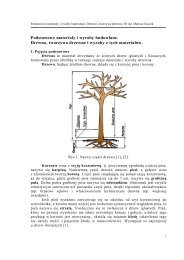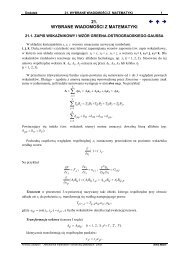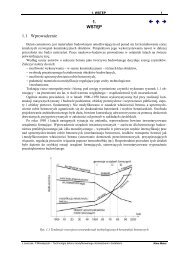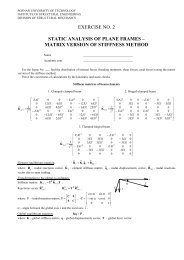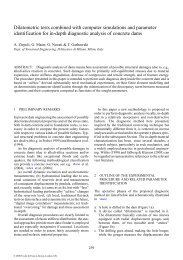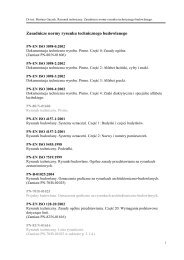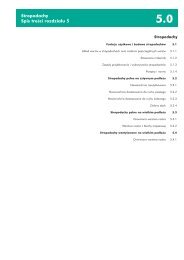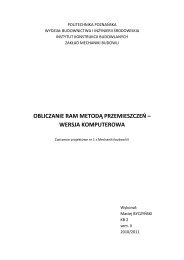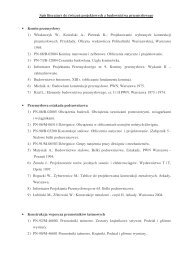Andrzej Pożarycki and Tomasz Garbowski / Procedia Eng<strong>in</strong>eer<strong>in</strong>g 57 ( 2013 ) 922 – 928927Samples: P02 vs P25 (PGM-G 100/100) - Mass per unit area: 430 g/m 2Fig. 4 The average paths <strong>of</strong> crack propagation <strong>in</strong> samples re<strong>in</strong>forced with chosen geosynthetics and the reference samples5. <strong>Laboratory</strong> and theoretical results discussionThe role <strong>of</strong> the re<strong>in</strong>forcement by geosynthetic materials with low flexural stiffness is checked here. First, us<strong>in</strong>g one <strong>of</strong> themethods <strong>of</strong> homogenization <strong>of</strong> composite with re<strong>in</strong>forced layer, where equivalent stiffness <strong>of</strong> re<strong>in</strong>forced course is computed(i.e. stiffness <strong>of</strong> the composite AC with geogrid). Based on the obta<strong>in</strong>ed results, as expected, the lack <strong>of</strong> efficiencies <strong>of</strong>re<strong>in</strong>forcement was observed (negative values <strong>in</strong> Tab. 3, last column). The example <strong>of</strong> calculation concerned only geogrid,however, due to the similar properties <strong>of</strong> the second material, one can expect the same results. In other words, if one th<strong>in</strong>ks<strong>of</strong> re<strong>in</strong>forcements as a stiffness improvement <strong>of</strong> the composite, formed from a mixture <strong>of</strong> asphalt and re<strong>in</strong>forc<strong>in</strong>g layer, thanthe mean<strong>in</strong>g <strong>of</strong> the application <strong>of</strong> the grid GG8550 or geocomposites PGM 100/100 for such solutions is questionable.The overall picture <strong>of</strong> re<strong>in</strong>forcement <strong>in</strong> these materials dramatically changes when subjected to the fatigue analysis. Inorder to check the fatigue resistance a large-scale laboratory test<strong>in</strong>g <strong>of</strong> the sample plate cut from the experimental section <strong>of</strong>asphalt layers is exam<strong>in</strong>ed here. Assess<strong>in</strong>g the effectiveness <strong>of</strong> the re<strong>in</strong>forcement <strong>in</strong> the form <strong>of</strong> relative measure whichtakes <strong>in</strong>to account only the number <strong>of</strong> cycles until the crack tip reaches the reference <strong>of</strong> + 2 cm (see Fig. 4) the follow<strong>in</strong>gobservations was taken:• The <strong>in</strong>crease <strong>of</strong> the fatigue life by 16% for samples re<strong>in</strong>forced with geogrid;• The <strong>in</strong>crease by 37% <strong>in</strong> the case <strong>of</strong> geocomposites` re<strong>in</strong>forcement.6. ConclusionsThe results showed that the test<strong>in</strong>g protocol presented <strong>in</strong> the paper is suitable for laboratory study<strong>in</strong>g the performance <strong>of</strong>re<strong>in</strong>forced large scale samples, mak<strong>in</strong>g possible to f<strong>in</strong>d out the difference between fatigue life <strong>of</strong> samples re<strong>in</strong>forced withdifferent materials. The results <strong>of</strong> the analysis revealed that:• Theoretical analysis <strong>of</strong> the re<strong>in</strong>forcement’s <strong>in</strong>fluence, reduced to assess the impact on the stiffness <strong>of</strong> the surrogatemodels <strong>of</strong> composite shows no improvement if re<strong>in</strong>forcement material has no bend<strong>in</strong>g stiffness.• The same types <strong>of</strong> materials (with no bend<strong>in</strong>g stiffness) assessed for fatigue life <strong>in</strong> laboratory conditions, on the largescalespecimens cut from the asphalt pavement layers, revealed the beneficial properties <strong>of</strong> such solutions. Geogrids<strong>in</strong>creased fatigue life by 16% <strong>in</strong> the case <strong>of</strong> geocomposites was an <strong>in</strong>crease over 35%.• The impact <strong>of</strong> geosynthetics should be judged only on the basis <strong>of</strong> the analysis which takes <strong>in</strong>to account the phenomenon<strong>of</strong> fatigue due to cyclic loads. There is a need to develop the theoretical methods to optimize the pavement design withthe use <strong>of</strong> re<strong>in</strong>forcement technologies.
928 Andrzej Pożarycki and Tomasz Garbowski / Procedia Eng<strong>in</strong>eer<strong>in</strong>g 57 ( 2013 ) 922 – 928References[1] Pasqu<strong>in</strong>i, E., Bocci M., Ferrotti, G., Canestrari F., 2012. <strong>Laboratory</strong> characterisation and field validation <strong>of</strong> geogrid-re<strong>in</strong>forced asphalt pavements, RoadMaterials and Pavement Design, iFirst, pp. 1–19.[2] Y<strong>in</strong>, J. H., 2000.Comparative model<strong>in</strong>g study <strong>of</strong> re<strong>in</strong>forced beam on elastic foundation, Journal <strong>of</strong> Geotechnical and Geoenvironmental Eng<strong>in</strong>eer<strong>in</strong>g126(3), pp. 265-271.[3] Perk<strong>in</strong>s, S. W., Edens, M. Q., 2002. F<strong>in</strong>ite Element and Distress Models for Geosynthetic-re<strong>in</strong>forced Pavements, The International Journal <strong>of</strong> PavementEng<strong>in</strong>eer<strong>in</strong>g 3(4), pp.239-250.[4] Perk<strong>in</strong>s, S.W., Edens, M. Q., 2003. A Design Model for Geosynthetic-re<strong>in</strong>forced Pavements, The International Journal <strong>of</strong> Pavement Eng<strong>in</strong>eer<strong>in</strong>g 4(1),pp. 37–50.[5] Dong, Y. L., Han, J., Bai, X. H., 2011. Numerical analysis <strong>of</strong> tensile behavior <strong>of</strong> geogrids with rectangular and triangular apertures, Geotextiles andGeomembranes 29, pp. 83-91.[6] Zornberg, J. G., 2011. Advances <strong>in</strong> the use <strong>of</strong> geosynthetics <strong>in</strong> pavement design, Geosynthetics India’11, 23-24 September 2011, IIT Madras, Chennai,KN-3 – KN-21.[7] Galve, J. P., Gutiérrez, F., Guerrero, J., Alonso, J., Diego, I., 2012. Optimiz<strong>in</strong>g the application <strong>of</strong> geosynthetics to roads <strong>in</strong> s<strong>in</strong>khole-prone areas on thebasis <strong>of</strong> hazard models and cost-benefit analyses, Geotextiles and Geomembranes 34, pp.80-92.[8] Zou, W. L., Wang, Z., Zhang, H. M., 2007. Field Trial for Asphalt Pavements Re<strong>in</strong>forced with Geosynthetics and Behavior <strong>of</strong> Glass-Fiber Grids,Journal <strong>of</strong> Performance <strong>of</strong> Constructed Facilities 21(5), pp. 361-367.[9] Laur<strong>in</strong>avičius, A., Og<strong>in</strong>skas, R., 2006. Experimental research on the development <strong>of</strong> rutt<strong>in</strong>g <strong>in</strong> asphalt concrete pavements re<strong>in</strong>forced with geosyntheticmaterials, Journal <strong>of</strong> Civil Eng<strong>in</strong>eer<strong>in</strong>g and Management XII(4), pp. 311–317.[10] Ferrotti, G., Canestrari, F., Pasqu<strong>in</strong>i, E., Virgili, A., 2012. Experimental evaluation <strong>of</strong> the <strong>in</strong>fluence <strong>of</strong> surface coat<strong>in</strong>g on fiberglass geogridperformance <strong>in</strong> asphalt pavements, Geotextiles and Geomembranes 34, pp. 11-18.[11] Tschegg, E. K., Jamek, M., Lugmayr, R., 2012. <strong>Crack</strong> growth behaviour <strong>in</strong> geosynthetic asphalt <strong>in</strong>terlayer systems, Road Materials and PavementDesign 13(1), pp.156–170.[12] Jamek, M., Tschegg E. K., Lugmayr, R., 2012. Mechanical and fracture–mechanical properties <strong>of</strong> geosynthetic re<strong>in</strong>forced asphalt systems, <strong>Fatigue</strong> &Fracture <strong>of</strong> Eng<strong>in</strong>eer<strong>in</strong>g Materials Structures 35, pp. 648–657.[13] Read, J. M., 2000. New Method for Measur<strong>in</strong>g <strong>Crack</strong> Propagation <strong>in</strong> Asphalts, International Journal <strong>of</strong> Pavement Eng<strong>in</strong>eer<strong>in</strong>g 1(1), pp. 15-34.[14] Lee, J., Fenves, G. L., 1998, Plastic-damage model for cyclic load<strong>in</strong>g <strong>of</strong> concrete structures, ASCE Journal <strong>of</strong> Eng<strong>in</strong>eer<strong>in</strong>g Mechanics 124(8), pp. 892-900.[15] Belytschko, T., Black, T., 1999. Elastic crack growth <strong>in</strong> f<strong>in</strong>ite elements with m<strong>in</strong>imal remesh<strong>in</strong>g, Internat. J. Numer. Methods Engrg. 45, pp. 601-620.[16] Lubl<strong>in</strong>er, J., Oliver, J., Oller, S. and Onate, E., 1989. A plastic-damage model for concrete, Int. Journal <strong>of</strong> Solids and Structures 25, pp. 299-326.[17] Ullidtz, P., 2002. Analytical Tools for Design <strong>of</strong> Flexible Pavements, <strong>in</strong> 8th ISAP Conference, Copenhagen, August 2002.[18] Sybilski, D., Jezierska, D., Maliszewski, M., Mularzuk, R., Jemioło, S. 2006. Analysis <strong>of</strong> pavement re<strong>in</strong>forcement ability with geogrids by us<strong>in</strong>g thef<strong>in</strong>ite element method. F<strong>in</strong>al report, Road and Bridge Research Institute, Pavement Technology Division, Warsaw, June 2006r (<strong>in</strong> Polish).[19] Grabowski, W., Pożarycki, A. 2008. An Energy Absorption In Large Dimension Asphalt Pavement Samples Re<strong>in</strong>forced With Geosynthetics,Foundations <strong>of</strong> Civil and Environmental Eng<strong>in</strong>eer<strong>in</strong>g 1.[20] Perk<strong>in</strong>s, S.W., Christopher, B. R., Cuelho, E. L., Eiksund, G. R., H<strong>of</strong>f, I., Schwartz, Ch. W., Svanø, G., Want, A., 2004. Development <strong>of</strong> DesignMethods for Geosynthetic Re<strong>in</strong>forced Flexible Pavements, F<strong>in</strong>al Report FHWA Report Reference: DTFH61-01-X-00068, May 25, 2004. Department<strong>of</strong> Civil Eng<strong>in</strong>eer<strong>in</strong>g, Montana State University – Bozeman, Bozeman, Montana 59717.


